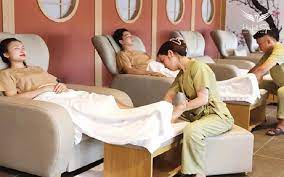In the tapestry of human wellness, few threads are as ancient and universally cherished as the art of 다낭 가라오케 순위별로 정리해드립니다 . From the bustling markets of ancient China to the serene temples of India, massage has been a cornerstone of healing and relaxation for millennia. But beyond its rich history, what makes massage so compelling in today’s world of high-tech solutions and fast-paced living? Let’s delve into the multifaceted nature of massage and explore its benefits, techniques, and the science behind its soothing touch.
The History and Evolution of Massage
Massage therapy traces its roots back to ancient civilizations. Historical records suggest that the Chinese were among the earliest practitioners, with references to massage in the Huangdi Neijing (Yellow Emperor’s Classic of Medicine), a foundational text on Chinese medicine. Meanwhile, in ancient Egypt, hieroglyphics depict the practice of massage, and the Greeks and Romans adopted and adapted it, integrating it into their sports and medical practices.
The journey of massage didn’t stop there. Over centuries, different cultures refined their techniques. In India, Ayurvedic massage developed as part of holistic health practices, focusing on balancing the body’s energies. Traditional Japanese Shiatsu emerged, influenced by Chinese acupuncture and aiming to restore harmony to the body’s meridians. This rich heritage continues to influence modern therapeutic practices.
The Science Behind the Touch
Massage might seem like a simple indulgence, but its benefits are backed by a growing body of scientific research. At its core, massage therapy involves manipulating the body’s soft tissues to improve circulation, relieve muscle tension, and promote relaxation. The science of massage delves into how these manipulations affect the body’s physiological and psychological states.
1. Improved Circulation and Muscle Recovery: Massage stimulates blood flow, which helps deliver oxygen and nutrients to tissues. This can accelerate muscle recovery, making it a popular choice among athletes and those recovering from injuries.
2. Reduction of Stress and Anxiety: Massage therapy has been shown to lower levels of cortisol, a hormone associated with stress. Simultaneously, it can increase the production of serotonin and dopamine, neurotransmitters that enhance mood and relaxation.
3. Pain Relief: Various types of massage, including Swedish, deep tissue, and myofascial release, are effective in alleviating pain. By targeting specific muscles and tissues, massage can reduce chronic pain conditions and improve overall comfort.
Types of Massage Techniques
Massage techniques are as diverse as their histories. Here’s a glimpse into some of the most popular types:
1. Swedish Massage: This is one of the most common forms of massage, known for its gentle strokes and emphasis on relaxation. Techniques include long, flowing strokes, kneading, and circular movements on the topmost layer of muscles.
2. Deep Tissue Massage: Focused on deeper muscle layers and connective tissues, deep tissue massage aims to release chronic muscle tension. It involves slower strokes and deeper pressure, which can be intense but often provides significant relief.
3. Shiatsu: A form of Japanese massage, Shiatsu uses finger pressure on specific points to balance energy flow (qi) in the body. It incorporates elements of acupressure and is intended to enhance overall well-being.
4. Hot Stone Massage: Smooth, heated stones are placed on specific points on the body and used as tools for massage. The heat helps relax muscles and allows for deeper manipulation.
5. Thai Massage: Combining elements of yoga, acupressure, and Ayurvedic principles, Thai massage involves stretching and gentle pressure. It’s performed on a mat on the floor, with the recipient fully clothed.
Integrating Massage into Modern Life
In today’s fast-paced world, integrating massage into your routine can be more than just a luxury—it can be a vital part of self-care. Regular massage sessions can help manage stress, improve sleep, and enhance overall quality of life.
For those new to massage, starting with a licensed therapist who can tailor the session to your needs is essential. Whether you’re seeking relief from specific issues or simply aiming for relaxation, communication with your therapist ensures you receive the most benefit.
Conclusion
Massage, with its deep historical roots and scientifically-supported benefits, remains a powerful tool for enhancing physical and mental well-being. As we continue to navigate the complexities of modern life, this ancient practice offers a timeless reminder of the power of touch and the importance of caring for ourselves. So next time you’re in need of relief or relaxation, consider indulging in the healing art of massage—it might just be the touch you need.



